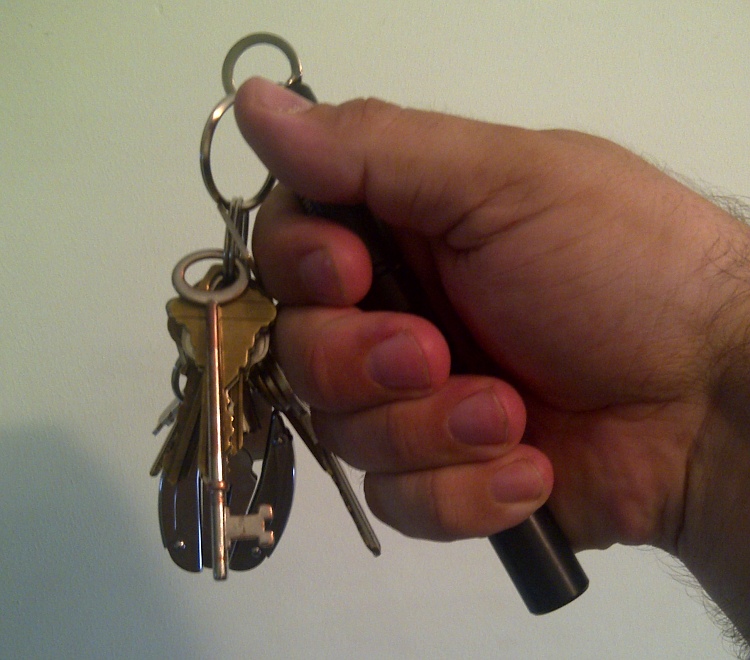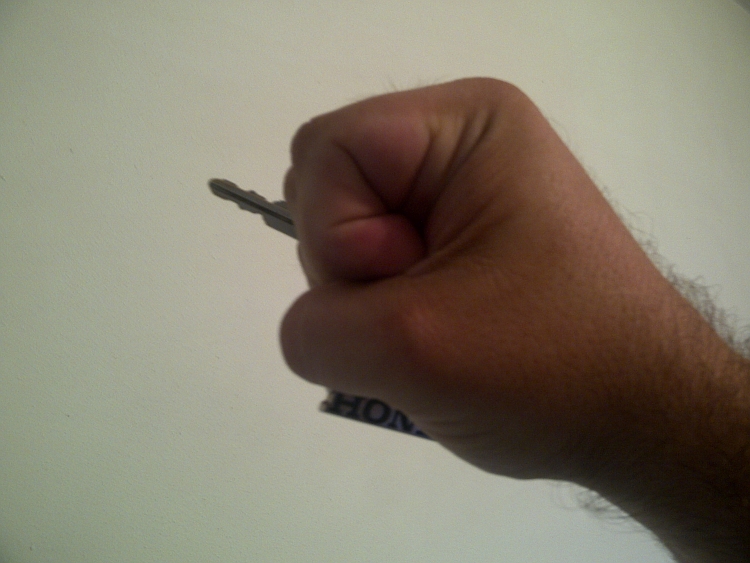One of those hoary old self-defense “tips” that has lingered well beyond all reasonable credibility for its application is the notion of key-flailing. In a neutered world whose citizens are allowed no implements of self-defense beyond innocuous pocket accessories, the idea that you could use your car- and house-keys to fend off rampaging hordes of subway muggers and whistle-fearing rapists holds a certain appeal. The problem is that key-flailing is an unutterably dumb idea. Not only is it ineffective for self-defense (beyond the benefit offered by the most momentary of distractions) , but it asks you to use as a weapon something that, in all likelihood, you really ought not risk losing.
The key-flail is most commonly recommended in conjunction with a kubotan-style keyring, which serves as the handle for the flail. What you do, when you flail with your keys in this manner, is waste an effective weapon (the pocket stick itself) as a way to grip and deploy an ineffective weapon (the keys). Even the heaviest wad of keys does not have the weight to do significant damage to a human being, no matter how hard those keys are whipped. Yes, a jagged piece of metal — or many of them — can be painful and distracting. Such a “weapon” is still much too light to have any real stopping power.
The exception when using keys as a self-defense implement is using them as makeshift penetrating tools. Keys thrust between your fingers can be used to rake and stab, especially when deployed against soft targets like the eyes or the hollow of the throat. Keep in mind, though, that holding them between your fingers like this will tear up your hands — you’re even better off just holding the key as you would hold it to open your car door, between thumb and forefinger, and pushing it home or scoring with it.
The conclusion any reasonable student of self-defense should reach is that keys used in this manner can be pressed into use for delivering physical force… but key-flailing techniques should be left in the realm of fantasy and bad advice.
Remember that when we talk about inflicting damage on an attacker, we are not talking merely about breaking the skin or making him flinch (or even causing him significant pain). We are talking about inflicting enough damage to stop an attack in progress — to put the assailant off balance and even to drop him to his knees or to the prone position. An aggressive enemy moving in on you with violent intent will not be stopped by a key-whip to the face any more than he will be dropped to the floor by an eye flick (although the latter is at least a reliable and controllable technique used to create an opening for follow-up).
When using your keys for self-defense (if you must), please remember that they should be used as gouging, penetrating tools, not as the tip of a makeshift flail. Whenever possible, however, try not to use your keys at all, as one presumes you carry them because they are important. If you use the keys with which you’ve just struck a mugger or a rapist, you don’t want to then find yourself locked out of your car or your house.


Dear Mr Elmore,
I carry my keys attached to an ASP “Key Defender”, which I tuck my keys inside my belt. You are correct in saying that keys alone are not viable as a “flail”. However, my keys contain an additional two rings to which I have attached a medium size brass padlock. My tests on various objects lead me to believe that “deadly force” is easily achieved.
Mike Russell